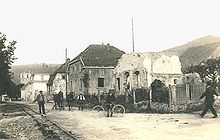Wattwiller
Wattwiller
Wǎttwillr | |
|---|---|
 A general view of Wattwiller | |
 Coat of arms | |
show Location of Wattwiller | |
 Wattwiller | |
| Coordinates: 47°50′13″N 7°10′51″E / 47.8369°N 7.1808°ECoordinates: 47°50′13″N 7°10′51″E / 47.8369°N 7.1808°E | |
| Country | France |
| Region | Grand Est |
| Department | Haut-Rhin |
| Arrondissement | Thann-Guebwiller |
| Canton | Cernay |
| Intercommunality | |
| Government | |
| • Mayor (2020–2026) | Mathieu Ermel |
| Area 1 | 13.61 km2 (5.25 sq mi) |
| Population (Jan. 2018)[1] | 1,649 |
| • Density | 120/km2 (310/sq mi) |
| Time zone | UTC+01:00 (CET) |
| • Summer (DST) | UTC+02:00 (CEST) |
| INSEE/Postal code | 68359 /68700 |
| Elevation | 266–1,121 m (873–3,678 ft) (avg. 360 m or 1,180 ft) |
| 1 French Land Register data, which excludes lakes, ponds, glaciers > 1 km2 (0.386 sq mi or 247 acres) and river estuaries. | |
Wattwiller (Alemannic German: Wǎttwillr; German: Wattweiler) is a commune in the Haut-Rhin department of the Grand Est region, which lies in the north-eastern part of France.

Wattwiller ruins in 1920
Located near the Vosges mountain rocky spur of Hartmannswillerkopf, Wattwiller was a strategic village in the Alsace, and suffered attacks in or near it during the Thirty Years' War and in both World Wars.
Nowadays Wattwiller is best known for its mineral water.

Mineral water plant

Wattwiller mineral water
Population[]
| Year | Pop. | ±% |
|---|---|---|
| 2006 | 1,714 | — |
| 2007 | 1,721 | +0.4% |
| 2008 | 1,727 | +0.3% |
| 2009 | 1,734 | +0.4% |
| 2010 | 1,741 | +0.4% |
| 2011 | 1,738 | −0.2% |
| 2012 | 1,731 | −0.4% |
| 2013 | 1,706 | −1.4% |
| 2014 | 1,681 | −1.5% |
| 2015 | 1,656 | −1.5% |
| 2016 | 1,646 | −0.6% |
See also[]
References[]
- ^ "Populations légales 2018". INSEE. 28 December 2020.
| Wikimedia Commons has media related to Wattwiller. |
Categories:
- Communes of Haut-Rhin
- Haut-Rhin geography stubs




